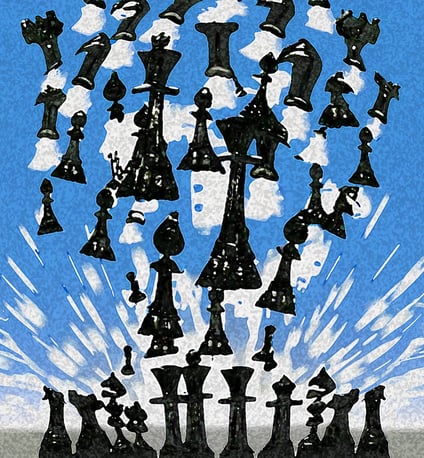Add your promotional text...
05. Explosion in Number of Games!
More chess games have been played in the past 5-10 years than in all of prior history combined!
Roy Prasad
3/9/20243 min read


Accelerating the wear and tear on chess is the sheer explosion in the number of chess games being played and recorded at a fairly high standard these days. It would not be an exaggeration to say more games have been played in the past 5-10 years, maybe even in the past 5 years, than in the entire prior history of chess.
The reason for this is threefold: One, there are now over a billion chess players in the world, which has led to a lot more people playing chess online, especially beginning with the pandemic year 2020. Two, shorter time-control chess games have become very popular, pushing chess closer to becoming a spectator sport. The classical tournament games are played with 2 to 2.5 hours given to 40 moves, followed by varying increments of time until the game ends. These days, Rapid, Blitz and Bullet formats have become very popular, and entire games are played within 30 minutes to as little as 5 minutes. Three, there are far more mini tournaments played within a short period of time (e.g., a weekend), with smaller but meaningful cash prizes provided by corporate sponsors and advertisers that even top level grandmasters find worth playing
According to chess.com, the most popular site for online chess, the number of games played on their site in 2023 was a mind-boggling 12.5 Billion, with monthly games now routinely in the 1 billion+ range. Besides chess.com, there are several other sites such as lichess.org that allow players to play on line.
Although vast majority of these games are played by amateurs and lower rated players, the number of games played by grandmasters and other chess professionals is still in the thousands.
The entire number of recorded games of former world champion for 27 years (1894-1921), Dr. Emanuel Lasker, including all tournament, match and casual games played over a period of 55 years, is a paltry 900. As of March 11, 2024, the number of recorded games for 20 year old Alireza Firouzja, Arjun Erigaisi and Nodirbek Abdusattorov are respectively 3105, 2707 and 2554!
All these games get stored in chess databases (e.g., Chessbase), and any game can be quickly fed into a chess engine to be analyzed to determine what move led to the loss of a game and what the better alternative moves were, so the next player who wants to play a certain opening variation knows what move to avoid on move 17, and so forth.
In the past, in the weeks and months following a major tournament, the games would be analyzed either by the players themselves or by other grandmasters and the games would be published in chess magazines, tournament books or game collections such as the Chess Informator. Today a game could be analyzed in minutes by anyone with a copy of Stockfish or another such program.
In the past, annotations to chess games used to reference other games previously played by grandmasters or international masters. These days it is increasingly common to see citations given to prior games played by club-level players with Elo ratings as low as 1500-1600. Innovation is within reach of average players with a copy of Stockfish, and players can find excellent new moves or promising new lines 20 moves deep in the Sicilian Najdorf.
The game of chess as it exists today is a finite and mathematically bound problem: the field is a board comprising only 64 squares. There are only six varieties of pieces for each side, and each piece has a precisely defined set of movements allowed. There are a total of 32 pieces that occupy 50% of the board, and as they are exchanged or captured, the number of pieces diminishes.
Although the combination of all the pieces makes it possible for many billions of unique and intelligent games (i.e., games not lost by elementary mistakes), it is still a finite set, like a candle of a fixed size that is now beginning to burn at an accelerated rate. What would normally have taken decades, perhaps even centuries, is now playing out in chess in a matter of months or years.
All this sheer volume of games, especially played between stronger, FIDE-rated players, are gradually but surely making the game more sterile. That means in competitive chess, players either have to play moves prescribed by the engines as the best, or play known inferior lines hoping their opponents may not know the refutation. Over time, this decreases the volume of games that are played on dirt roads and increases the volume of games played on well-paved highways that lead to sterility and repeated games!
It is time to infuse chess with new life that can withstand 10+ billion games being played every year!